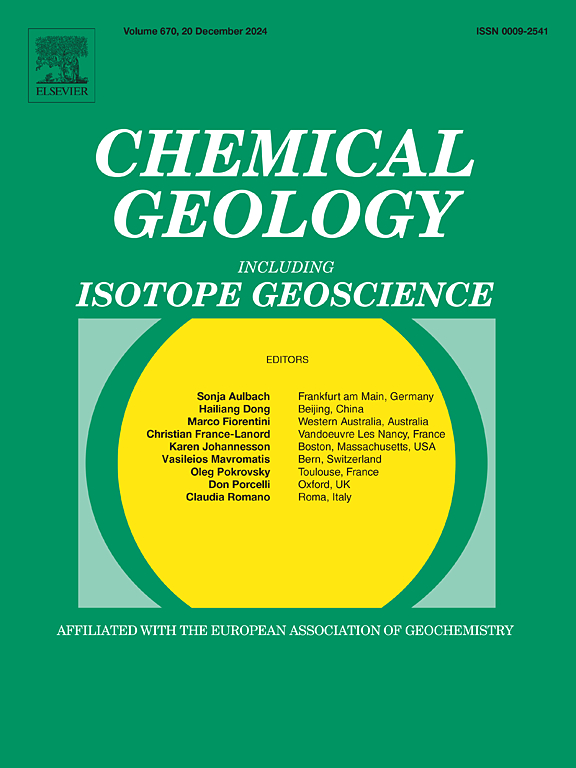Co-application of rhenium, vanadium, uranium and molybdenum as paleo-redox proxies: Insight from modern and ancient environments
IF 3.6
2区 地球科学
Q1 GEOCHEMISTRY & GEOPHYSICS
引用次数: 0
Abstract
Numerous approaches have been developed for determining past redox conditions in marine settings (e.g., Fe speciation, redox sensitive trace metal (RSTM) systematics, pyrite morphologies, I/(Ca + Mg) ratios), enabling a broad range of redox conditions, from fully oxic to euxinic, to be potentially identified. However, many points along this spectrum remain difficult to constrain, including dysoxic and highly versus weakly euxinic conditions. This limits the broader scale inferences that can be drawn from paleoredox studies, including links between oxygen availability and biological evolution, and the potential for isotope systems (e.g., Mo) to record water column signals. Here, we develop a new approach using RSTM ratios (Re/Mo, Re/U, Re/V, Mo/U), in combination with modified RSTM enrichment factors (EF⁎) and MoEF⁎-UEF⁎ cross-plots, that potentially enables a robust, highly resolved reconstruction of ancient water column redox conditions to be achieved. We initially document the differential behaviour of RSTM EF⁎ values and ratios in modern settings that range from fully oxygenated, through weakly (30–90 μM O2) and highly (<30 μM O2) dysoxic, to anoxic non-sulfidic and euxinic conditions. This redox behaviour is further resolved when the drawdown mechanisms for Mo are evaluated by MoEF⁎-UEF⁎ cross-plots. We subsequently ground-truth this approach by considering samples from the Carboniferous Bowland Basin, which have previously been studied for redox conditions via independent geochemical and mineralogical techniques, as well as the Jurassic Kimmeridge Clay Formation, where redox conditions have been defined based on paleoecological characteristics. A strong degree of consistency between RSTM behaviour in modern and ancient settings highlights that weakly to highly dysoxic conditions are characterized by increases in Re/Mo, Re/U and Re/V ratios, accompanied by RSTM EF⁎ values that only become notably enriched under highly dysoxic conditions. Non-sulfidic water column anoxia is indicated by increased UEF⁎ values and low Re/Mo ratios, while euxinia is readily identified by high Mo/U, low Re/U and very low Re/Mo ratios, alongside high MoEF⁎ values. In addition, highly euxinic conditions may be distinguished from weak euxinia by particularly high Mo/U ratios and MoEF⁎ values. This combined approach has the potential to provide a hitherto unprecedented level of insight into paleodepositional redox conditions, and consequently the chemical evolution of the biosphere.
铼、钒、铀和钼作为古氧化还原指标的共同应用:来自现代和古代环境的启示
已经开发了许多方法来确定海洋环境中过去的氧化还原条件(例如,铁形态,氧化还原敏感痕量金属(RSTM)系统,黄铁矿形态,I/(Ca + Mg)比率),从而可以确定从全氧到缺氧的广泛氧化还原条件。然而,这一光谱中的许多点仍然难以限定,包括缺氧和高氧与弱氧条件。这限制了从古氧化还原研究中得出的更广泛的推论,包括氧可用性与生物进化之间的联系,以及同位素系统(例如Mo)记录水柱信号的潜力。在这里,我们开发了一种使用RSTM比率(Re/Mo, Re/U, Re/V, Mo/U)的新方法,结合改进的RSTM富集因子(EF)和MoEF -UEF交叉图,可以实现古水柱氧化还原条件的鲁棒性,高分辨率重建。我们最初记录了现代环境下RSTM EF值和比率的差异行为,范围从完全氧合,到弱(30 - 90 μM O2)和高(30 μM O2)缺氧,再到缺氧非硫和缺氧条件。当通过MoEF -UEF交叉图评估Mo的下降机制时,这种氧化还原行为得到了进一步解决。随后,我们通过考虑石炭系Bowland盆地的样品,以及侏罗纪Kimmeridge粘土组的样品,对这种方法进行了实地验证。石炭系Bowland盆地以前通过独立的地球化学和矿物学技术研究过氧化还原条件,侏罗纪Kimmeridge粘土组的氧化还原条件是根据古生态特征定义的。现代和古代环境中RSTM行为之间的高度一致性突出表明,弱至高度缺氧条件的特征是Re/Mo, Re/U和Re/V比率的增加,伴随着RSTM EF值仅在高度缺氧条件下才显着富集。非硫化氢水柱缺氧表现为UEF值升高和低Re/Mo比值,而缺氧则表现为高Mo/U、低Re/U和极低Re/Mo比值以及高MoEF值。此外,高氧条件可以通过特别高的Mo/U比和MoEF - f值与弱氧条件区分开来。这种综合方法有可能提供迄今为止前所未有的对古沉积氧化还原条件的深入了解,从而了解生物圈的化学演化。
本文章由计算机程序翻译,如有差异,请以英文原文为准。
求助全文
约1分钟内获得全文
求助全文
来源期刊

Chemical Geology
地学-地球化学与地球物理
CiteScore
7.20
自引率
10.30%
发文量
374
审稿时长
3.6 months
期刊介绍:
Chemical Geology is an international journal that publishes original research papers on isotopic and elemental geochemistry, geochronology and cosmochemistry.
The Journal focuses on chemical processes in igneous, metamorphic, and sedimentary petrology, low- and high-temperature aqueous solutions, biogeochemistry, the environment and cosmochemistry.
Papers that are field, experimentally, or computationally based are appropriate if they are of broad international interest. The Journal generally does not publish papers that are primarily of regional or local interest, or which are primarily focused on remediation and applied geochemistry.
The Journal also welcomes innovative papers dealing with significant analytical advances that are of wide interest in the community and extend significantly beyond the scope of what would be included in the methods section of a standard research paper.
 求助内容:
求助内容: 应助结果提醒方式:
应助结果提醒方式:


